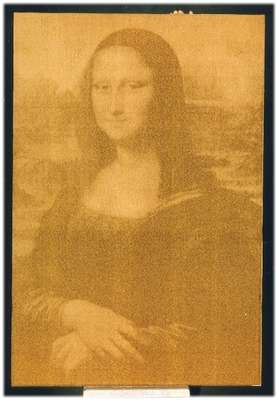Computer-aided drawing, produced on a Calcomp 30-inch plotter.
Because of the technique of its generation, the Digital Mona Lisa is also known as Mona by Numbers.
H. Philip Peterson of Control Data Corporation (CDC) used a CDC 3200 computer and a scanner (that he called “flying-spot”) to create in 1964 a digital transposition of Leonardo da Vinci’s famous painting, “Mona Lisa” (done in 1503/04). He thus created a digital representation of the analogue original. Peterson’s generative idea was to consider the original painting as a grid of small colored dots (now called “pixels”). The colors were, however, reduced to only grey of various shades. These shades of grey were realized on a Calcomp plotter by using numerical characters, some overprinting others to approximate the grey levels. This production process took 14 hours to complete the image of 100,000 pixels. (See http://www.digitalmonalisa.com)
The three illustrations are showing the image at different levels of detail thus making visible the use of the numerals.





